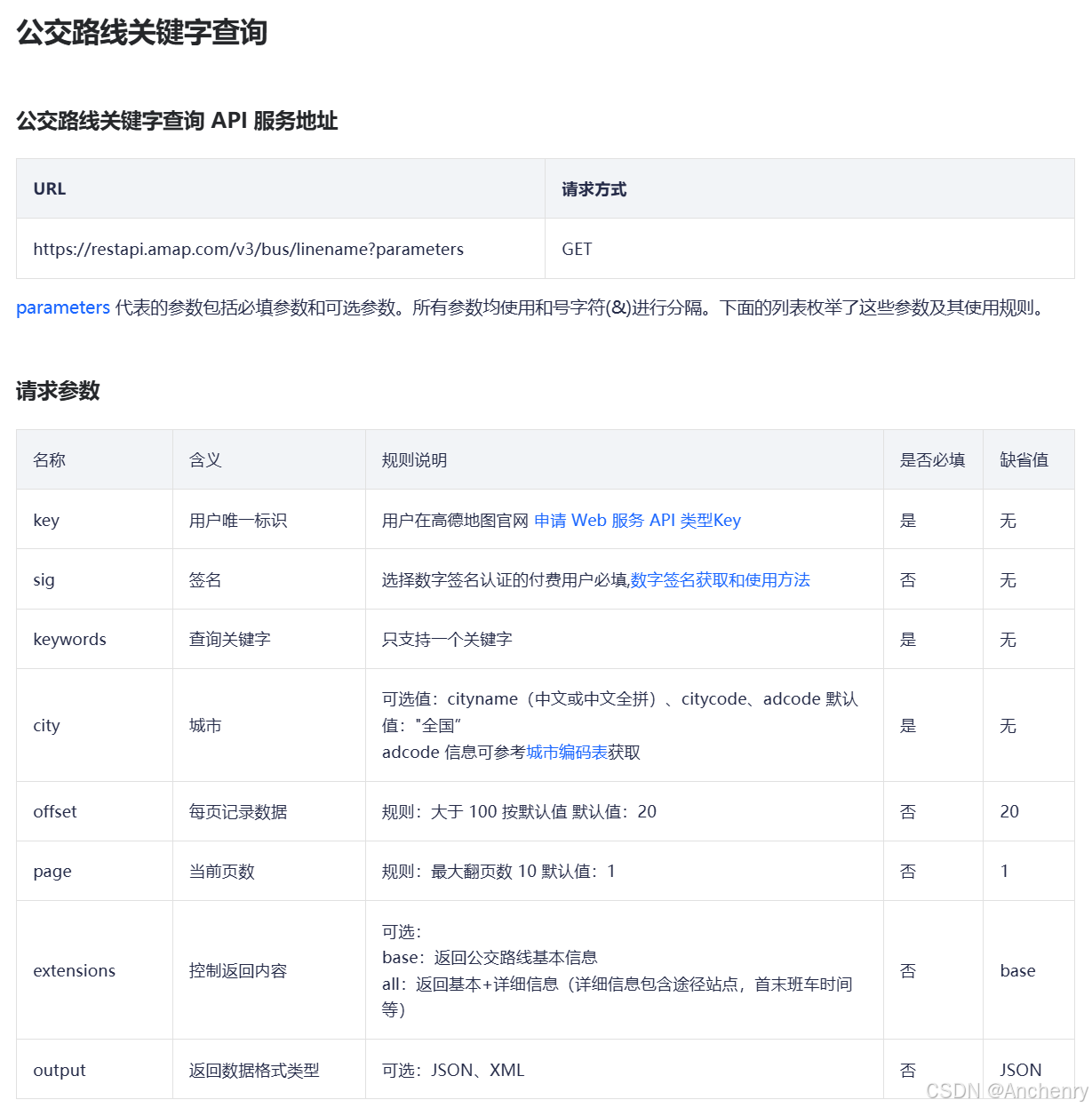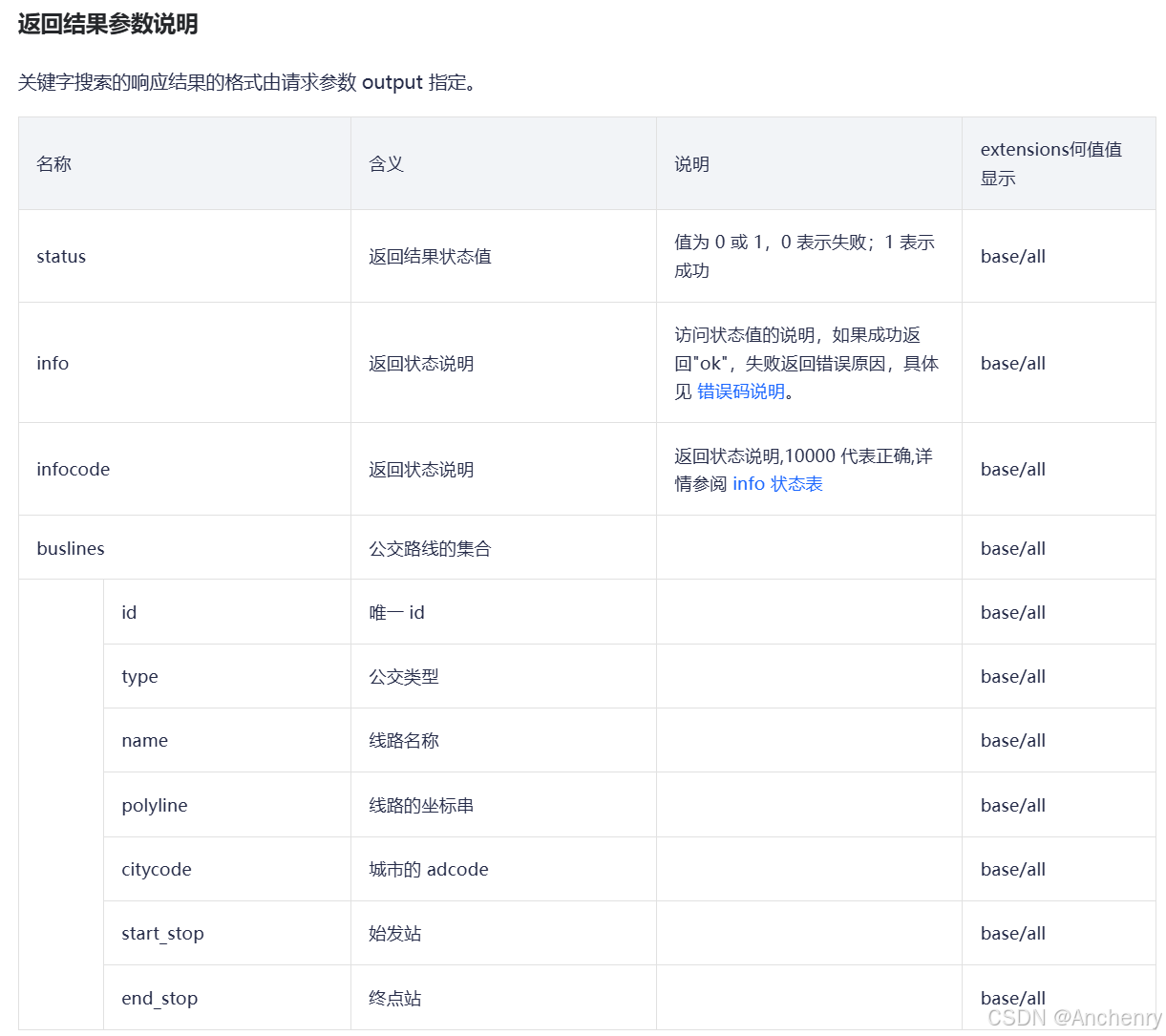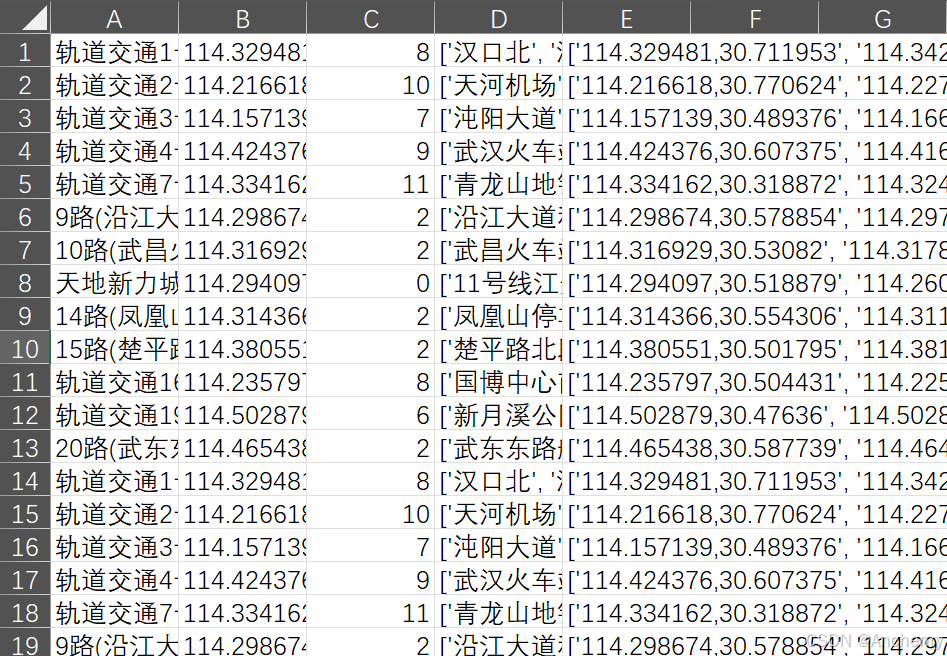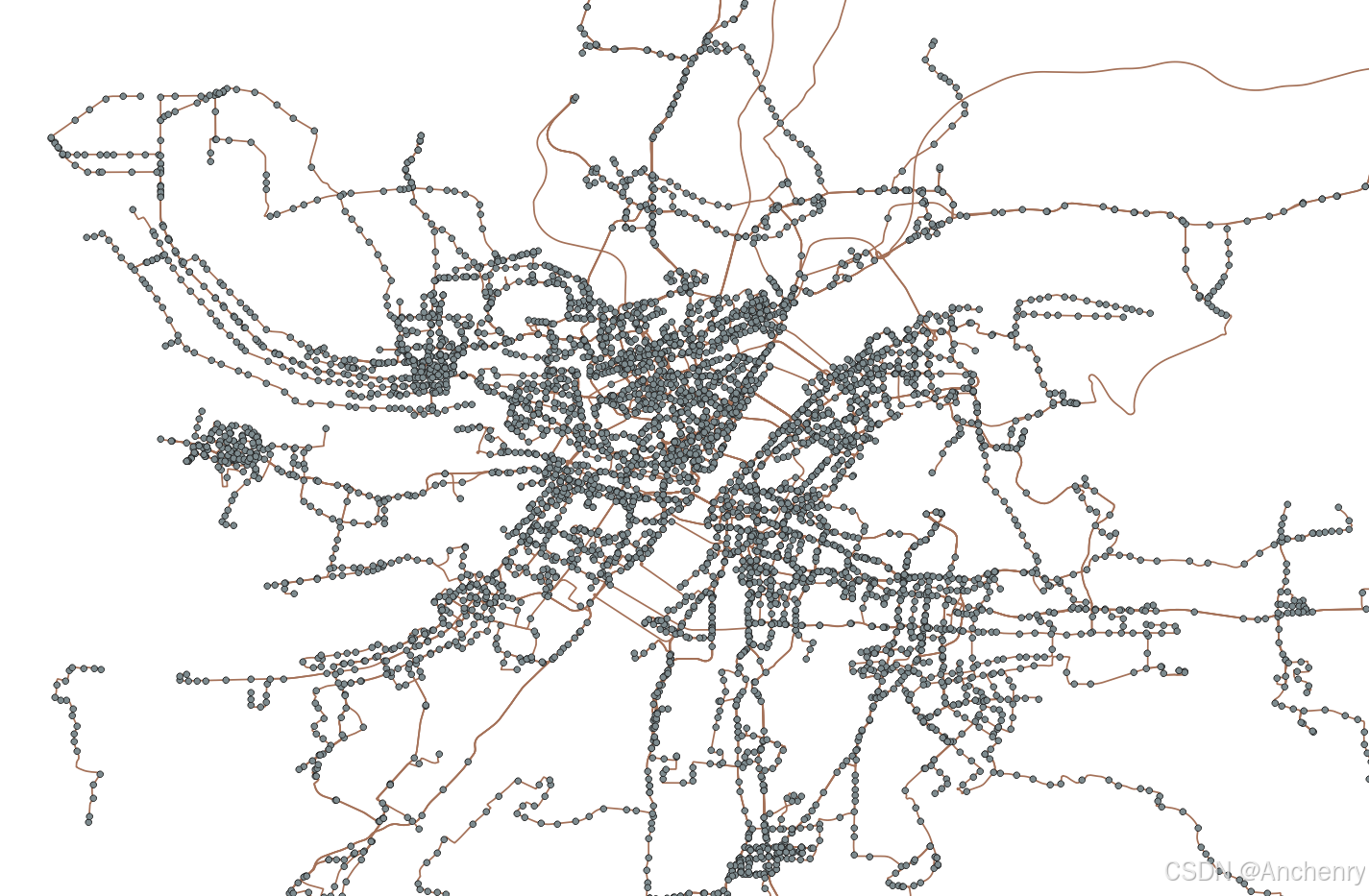程序來自于Github,以下這篇博客作為完整的學習記錄,也callback上一篇爬取公共交通站點的博文。
Bardbo/get_bus_lines_and_stations_data_from_gaode: 這個項目是基于高德開放平臺和公交網獲取公交線路及站點數據,并生成shp文件,代碼相對粗糙,但簡單可用![]() https://github.com/Bardbo/get_bus_lines_and_stations_data_from_gaode
https://github.com/Bardbo/get_bus_lines_and_stations_data_from_gaode
1. 導入庫
首先是程序需要的python庫。
import requests
import json
import pandas as pd
from lxml import etree
import time
from tqdm import tqdm-
requests:用于發送HTTP請求,獲取網頁內容或API數據。 -
json:用于處理JSON格式的數據。 -
pandas:用于數據處理和保存為CSV文件。 -
lxml:用于解析HTML內容。 -
time:用于控制爬取速度,避免過快請求導致被封禁。 -
tqdm:用于顯示進度條,方便查看爬取進度。
2.?獲取城市公交線路名稱(get_bus_line_name?函數)
def get_bus_line_name(city_phonetic):url = 'http://{}.gongjiao.com/lines_all.html'.format(city_phonetic)r = requests.get(url).textet = etree.HTML(r)line_name = et.xpath('//div[@class="list"]//a/text()')return line_name這里同樣也需要先爬取公交線路的名稱,函數需要傳入city_phonetic也就是城市的拼音(如?changsha、wuhan),函數會返回該城市所有公交線路的名稱列表(line_name)。
3. 爬取公交路線(get_line_station_data?函數)
獲取公交線路的url是高德的https://restapi.amap.com/v3/bus/linename?extensions=all&key={ak}&output=json&city={city}&offset=1&keywords={line_name}
那么先來看一下官方的介紹,這里使用的是公交路線關鍵字查詢,也就是說我們要輸入公交路線的關鍵字,例如15路等等。

返回的內容如下,status記錄了查詢成功與否,buslines中記錄了查詢成功的公交路線。

接下來來看代碼:
def get_line_station_data(city, line_name, ak, city_phonetic):print(f'正在獲取-->{line_name}')time.sleep(1)url = f'https://restapi.amap.com/v3/bus/linename?extensions=all&key={ak}&output=json&city={city}&offset=1&keywords={line_name}'r = requests.get(url).textrt = json.loads(r)try:if rt['buslines']:if len(rt['buslines']) == 0:print('no data in list..')else:dt = {}dt['line_name'] = rt['buslines'][0]['name']dt['polyline'] = rt['buslines'][0]['polyline']dt['total_price'] = rt['buslines'][0]['total_price']station_name = []station_coords = []for st in rt['buslines'][0]['busstops']:station_name.append(st['name'])station_coords.append(st['location'])dt['station_name'] = station_namedt['station_corrds'] = station_coordsdm = pd.DataFrame([dt])dm.to_csv(f'{city_phonetic}_lines.csv',mode='a',header=False,index=False,encoding='utf_8_sig')else:print('data not avaliable..')with open('data not avaliable.log', 'a') as f:f.write(line_name + '\n')except:print('error.. try it again..')time.sleep(2)get_line_station_data(city, line_name, ak, city_phonetic)函數通過高德地圖API獲取某條公交線路的詳細信息,并保存到CSV文件中。通過構造API請求URL獲取公交線路數據,解析響應并提取線路名稱、路徑、票價、站點名稱和坐標,將數據保存到CSV文件,若數據不可用則記錄日志,失敗時等待2秒后重試。
如果爬取失敗的話,檢查一下key是否達到了限額,一天只能爬取5000次,爬取公交線路比較耗費次數。
爬取完成后來看一下保存的csv,總共5列。
- A列:公交線路關鍵字(名稱)
- B列:公交線路polyline,也就是線路途徑的每個點(注意不是站點,公交線路的每個拐點都會被記錄)
- C列:總價
- D列:途徑站點關鍵字(名稱)
- E列:途徑站點經緯度坐標

4. 主程序調用
if __name__ == '__main__':city = '益陽'city_phonetic = 'yiyang'ak = '###' # 這里建議更改為自己的keystart_time = time.time()print(f'==========正在獲取 {city} 線路名稱==========')line_names = get_bus_line_name(city_phonetic)print(f'{city}在公交網上顯示共有{len(line_names)}條線路')for line_name in tqdm(line_names):get_line_station_data(city, line_name, ak, city_phonetic)end_time = time.time()print(f'我爬完啦, 耗時{end_time - start_time}秒')自己需要設置的是最開始的city、city_phonetic、ak.
程序調用了上面的函數并記錄了爬取的時間。
5. 線路、站點轉成shp
那么有了這個csv怎么可視化呢?
那么作者就寫了DataToShp這個?類用于將公交線路和站點數據從CSV文件轉換為Shapefile格式,主要功能包括:
get_station_data:將站點坐標和名稱從字符串格式轉換為列表格式,將數據從橫向展開為縱向,并去除重復項;
get_line_data:將線路的折線數據從字符串格式轉換為列表格式;
create_station_shp:創建站點Shapefile,包含站點名稱和坐標;
create_lines_shp:創建線路Shapefile,包含線路名稱和折線坐標;
其實作者其實在這里還引入了從高德的火星坐標系轉換為WGS_84的函數,但是大部分時候這種轉換并不可靠,所以建議高德爬取的數據就搭配高德地圖進行可視化使用。
# -*- coding: utf-8 -*-
# @Author: Bardbo
# @Date: 2020-11-09 21:09:12
# @Last Modified by: Bardbo
# @Last Modified time: 2020-11-09 21:59:35
import pandas as pd
import numpy as np
import shapefile
# import converterclass DataToShp:def __init__(self, filename):self.data = pd.read_csv(filename,names=['line_name', 'polyline', 'price','station_names', 'station_coords'])def get_station_data(self):df_stations = self.data[['station_coords', 'station_names']]# 將原本的一行字符串變為列表df_stations['station_coords'] = df_stations['station_coords'].apply(lambda x: x.replace('[', '').replace(']', '').replace('\'', '').split(', '))df_stations['station_names'] = df_stations['station_names'].apply(lambda x: x.replace('[', '').replace(']', '').replace('\'', '').split(', '))# 橫置的數據變為縱向的數據station_all = pd.DataFrame(\np.column_stack((\np.hstack(df_stations['station_coords'].repeat(list(map(len, df_stations['station_coords'])))),np.hstack(df_stations['station_names'].repeat(list(map(len, df_stations['station_names'])))))),columns=['station_coords','station_names'])# 去除重復station_all = station_all.drop_duplicates()# # 坐標轉換# station_all['st_coords_wgs84'] = station_all['station_coords'].apply(# self.stations_to_wgs84)station_all.reset_index(inplace=True)self.stations = station_alldef get_line_data(self):df_lines = self.data[['line_name', 'polyline']]df_lines['polyline'] = df_lines['polyline'].apply(lambda x: x.split(';'))# # 坐標轉換# df_lines['lines_wgs84'] = df_lines['polyline'].apply(# self.lines_to_wgs84)df_lines.reset_index(inplace=True)self.lines = df_lines# def stations_to_wgs84(self, coor):# xy = coor.split(',')# lng, lat = float(xy[0]), float(xy[1])# return converter.gcj02_to_wgs84(lng, lat)## def lines_to_wgs84(self, coor):# ls = []# for c in coor:# xy = c.split(',')# lng, lat = float(xy[0]), float(xy[1])# ls.append(converter.gcj02_to_wgs84(lng, lat))# return lsdef create_station_shp(self, city_phonetic):w = shapefile.Writer(f'./data/{city_phonetic}_stations.shp')w.field('name', 'C')# 確保所有坐標都是浮動類型for i in range(len(self.stations)):coords = self.stations.loc[i, 'station_coords'].split(',') # 獲取坐標lat = float(coords[0]) # 強制轉換為浮動類型lon = float(coords[1]) # 強制轉換為浮動類型# 確保坐標是浮動類型w.point(lat, lon) # 寫入點w.record(self.stations.loc[i, 'station_names']) # 寫入記錄w.close()def create_lines_shp(self, city_phonetic):w = shapefile.Writer(f'./data/{city_phonetic}_lines.shp')w.field('name', 'C')for i in range(len(self.lines)):polyline = self.lines['polyline'][i]# 如果 polyline 是字符串,則使用 split();如果是列表,則直接使用if isinstance(polyline, list):polyline = [list(map(float, point.split(','))) for point in polyline]# 確保 polyline 是列表類型,進行寫入w.line([polyline])w.record(self.lines['line_name'][i])w.close()if __name__ == '__main__':dts = DataToShp('yiyang_lines.csv')dts.get_station_data()dts.get_line_data()dts.create_station_shp()dts.create_lines_shp()print('shp文件創建完成')如下就是可視化后的效果【爬的時候無意中發現學校這多了兩條公交,深入鄂州,win!】










)





)



)